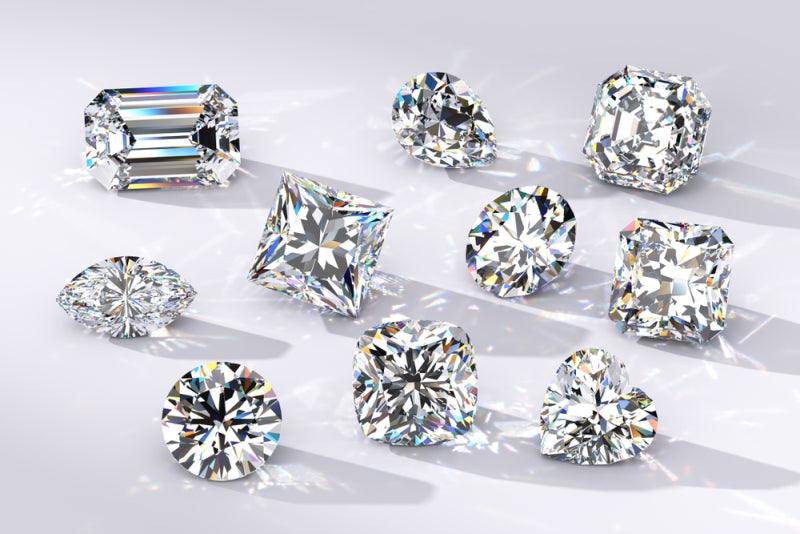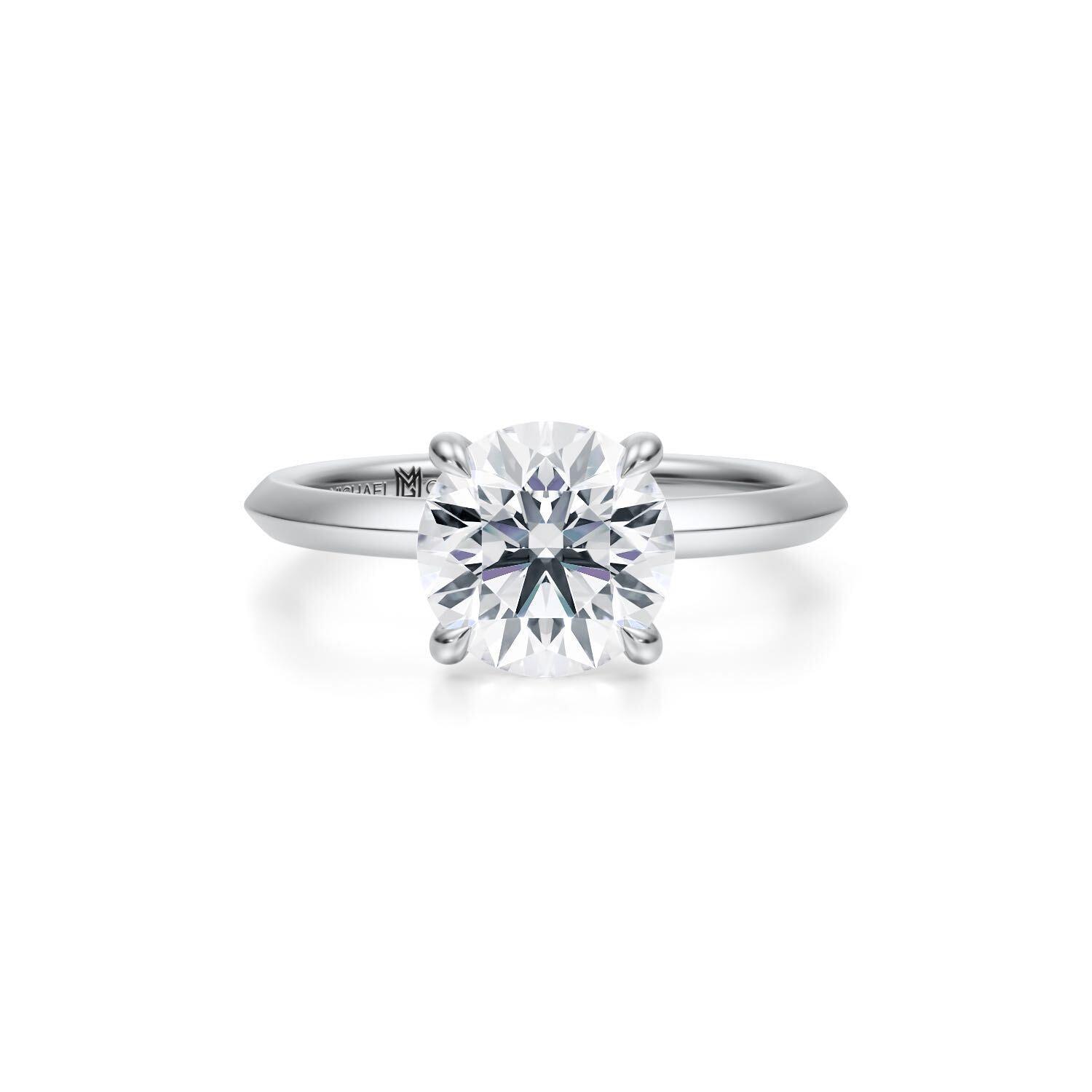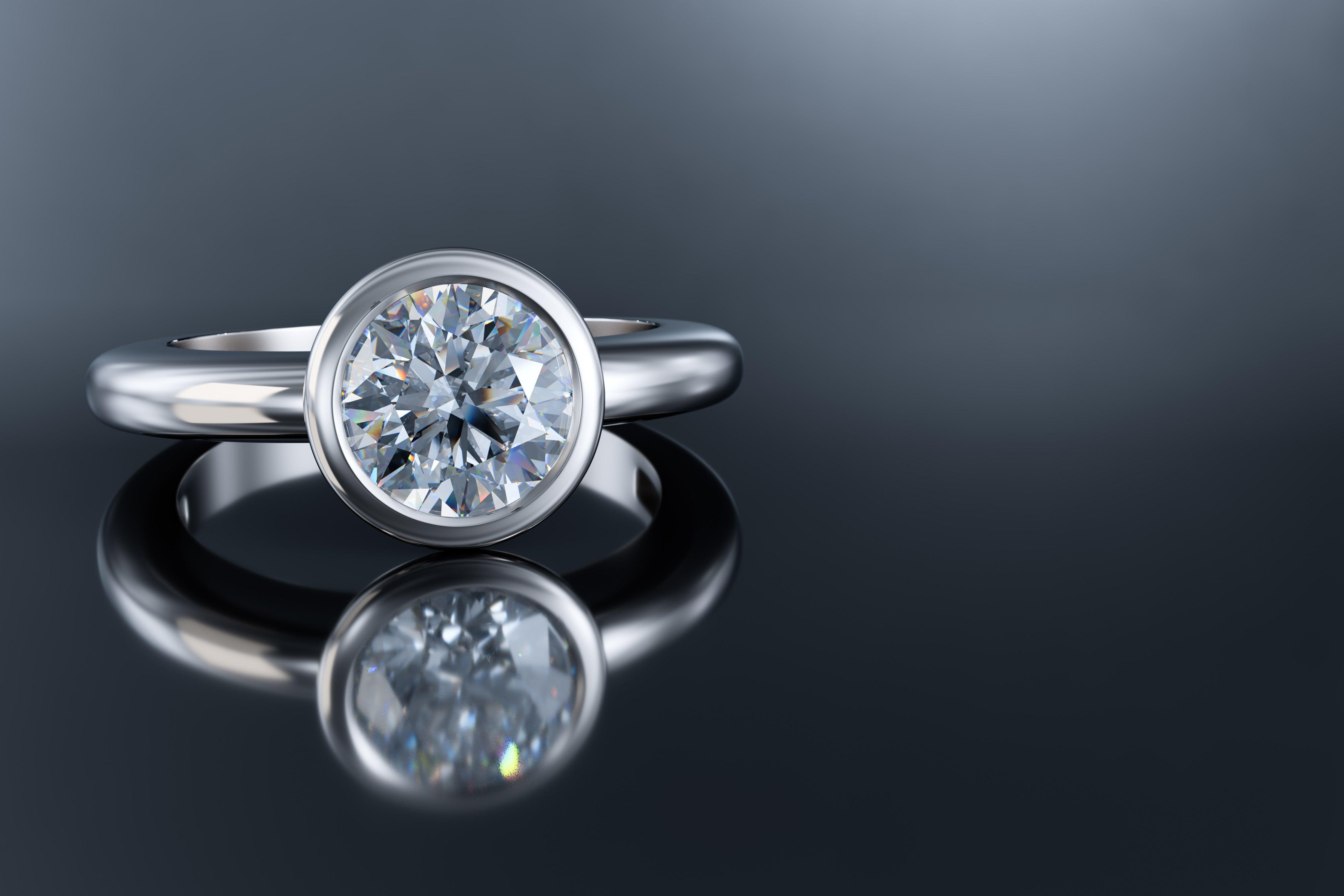
The Ultimate Guide to the 4 Cs of a Diamond
Are you looking for the perfect diamond for you or your partner but are confused as to how to select the right one? Do you have concerns about the sustainability of your diamond, but aren’t sure how lab-grown diamonds compare to mined diamonds in terms of the 4Cs. So is picking one turning into a frustrating endeavor?
Are you flabbergasted at the range in prices for stones all of the same relative carat weight? Do you worry because you keep viewing diamonds but can't really figure out what makes one better than the other?
Have you been trying to stay patient and sane while you click on options for computer algorithms to show you stones and have no idea how to choose? Do you even know if what you see on the screen really means anything, or if the stone will appear as it does when you finally see it in real life? I mean, you aren’t shopping for a diamond to wear in the metaverse after all; it needs to sparkle on a real finger in real daylight.
Have you been trying to decipher the gem reports from labs and are still confused?
Well, this blog is just for you. We are going to simplify and explain the 4Cs of diamonds and give you tips on purchasing a sustainable, lab-grown diamond you or your partner will love wearing.The four Cs, as you may already know, are Carat, Color Clarity, and Cut. But, knowing what they mean and how to evaluate a stone’s four Cs can make a big difference when designing the perfect piece!
Terms to Keep in Mind When Looking at the 4 Cs of a Diamond
When evaluating the 4 Cs of a diamond, there are some other diamond terms to keep in mind, which will be useful later as well in appreciating your gem. Diamonds are amazing minerals, whose atomic structure reflects and refracts light unlike any other. When a diamond is cut and shaped and polished just right, they produce dazzling, colorful, hypnotic, even almost kaleidoscopic light effects. Those effects are often described using the terms “Brilliance, Scintillation, and Fire,” but what do they really mean?
Simplified, Brilliance is, a creamy to icy, bright white light; Scintillation is the extreme light and dark contrasts that glitter and sparkle; Fire is the prismatic color resulting from the different wavelengths of light being broken up inside the atomic carbon-crystal lattice to produce all those delicious little rainbows.
Keep these terms in mind as we dive into the 4 Cs of a diamond.
Lab-Grown Diamonds vs Mined diamonds
One common question we receive at Michael Gabriels is whether the 4 Cs of a diamond change at all when considering lab-grown diamonds.
The simple answer is no, they do not change.
Lab-grown diamonds are produced in labs and factories, but they are chemically, structurally, and optically the same as mined diamonds. Therefore, a diamond’s 4 Cs are exactly the same for lab-grown diamonds as they are for mined diamonds.
The major differences between the two are the manner in which they are obtained and the time in which it takes them to grow. In nature, diamonds are created in anywhere from a matter of seconds to tens of millions of years. In a laboratory, they are created within a framework of days and weeks.
When considering Lab-grown diamonds, your only real concern should be whether they have been evaluated by an expert third party and that you receive the report from that evaluation. This will give you more surety on the 4 Cs for that stone.
Michael Gabriels’ lab-grown round diamonds are all evaluated on the 4 Cs of a diamond in IGI laboratories, the foremost evaluator of lab-grown diamonds in the world. When you pick a stone, you will receive an entire report from that lab. Along with the 4 Cs, this blog will walk you through some of the most important parts of that report.
Facets are the numerous flat surfaces polished on the diamond that together produce the overall diamond shape and provide “windows” into the stone, allowing light to enter, be refracted, dispersed, and leave. How well they are fashioned determines the diamond's ability to interplay and interact with light, and the cut evaluates the precision of that polishing.
1. Carat
Carat, the first of the 4 Cs of a diamond, is the universal measure of the weight of diamonds, which is now equal to 200mg. It is not a measure of size but only weight, so a 2-carat diamond will weigh twice as much as a 1-carat stone, but will not be twice the size. Size is measured in millimeters, and has no special term.
The etymology of carat is actually pretty interesting and harkens back to ancient times. It stems back to when the diamond trade was mainly by caravan from the Indian subcontinent—which for millennia served as the world's sole supply of diamonds— across the Arab world, and to Europe, largely by way of Italy.
Ceratonia siliqua, the carob tree, grew all along that route, and gem traders in antiquity used the seeds to measure the weight of gems, believing that they were uniform in weight no matter where in the world. Despite this erroneous belief, the seeds took root, since “carat” is derived from Italian carato, borrowed from Arabic qyrat, which is in turn derived from the Greek word Keration.
It's important not to confuse carat with Karat, the common term used to denote the purity of gold.
While carat weight is easy to romanticize and worry about, it's actually the least important of the 4 Cs of a diamond. This is because the appearance of the stone is largely unaffected by the weight, including, to a limited extent, how large it looks. Indeed, a 1 carat marquise shaped diamond may look almost twice as large as a 1 carat round stone.
The diamond's carat weight can also be misleading since the majority of the diamond's substance may be found in areas of the stone that are less visible than the crown and table in typical settings, such as the pavilion or girdle.
2. Color
Color is the second of the 4 Cs of diamonds. Diamonds are known as bright white stones, but they are often slightly tinted, and in rare cases, full of vivid color. This is the case for lab-grown as well as mined diamonds.
Diamonds with vibrant colors that are labeled “fancy colored diamonds” are extremely rare and are incredibly expensive. They sometimes cost tens of thousands, even hundreds of thousands, and in some cases millions more than a white-colored diamond of the same carat weight.
Most gem-quality diamonds count as white diamonds even if they have some tint. IGI grades diamond color from D to Z, with Z being a diamond of significant brown or yellow tinting, but not enough vividness to count for a fancy colored diamond.D represents a pure white, tintless diamond.
“Colorless” grades D, E&F are the highest given by IGI. A diamond with a grade of D has no color even under magnification. To the naked eye, E and F look identical, and they also have almost no apparent color. Only a trained gemologist will be able to distinguish between these grades.
Nearly Colorless diamonds are graded G-J. To the naked eye, these range from almost colorless to only very, very slightly tinted. When cut well, and in the proper settings, they may even be indistinguishable from D-F graded stones.
Diamonds with a faint but noticeable tint to the naked eye are graded in the K-M range.
While still very lightly tinted, diamonds with a grade of N-R have a noticeable brown or yellow hue.
Very noticeably tinted stones are graded S-Z.
Michael Gabriels takes this 4 C very seriously by only carrying the highest quality, colorless or nearly colorless lab-grown diamonds. However, we are able to help you produce an unparalleled work of art using tinted stones if that is your preference.
Settings, cut shapes, and carat weight all affect the apparent color of a diamond.
Step-cut stones that maximize brilliance tend to reveal a stone’s true color more, while brilliant-cut diamonds may mask a slight tint by optimizing fire and scintillation.
Cuts with thick girdles will show more of a diamond’s tint while thinner girdled stones allow more light to shine through the stone, and will expose less of a diamond’s tint.
Settings that give the diamond a lot of light will not be able to mask as much color as settings where the light reaching the diamond is more limited.
Likewise, settings of yellow gold or rose gold can complement a very slight tint enough to completely mask it, effectively allowing the stone to shine completely white.
3. Clarity
The third of the 4 Cs of a diamond is clarity. Whether lab-grown or mined, all diamonds can form inclusions - the blemishes you might see in or on the stone. Inclusions frequently develop in diamonds because they are formed in nature among a variety of possible obstacles, including materials, elements, heat, and pressure ranges.
They can be anything from another gemstone (garnets are actually very common inclusions) to grains of dirt, or some of the non-metamorphosed material the diamond originally formed from. These represent inclusions brought about by foreign objects.
Shifts in the diamond structure while forming, and changes in pressure and temperature can cause other inclusions, such as feathering, which is a potentially damaging fracture within the diamond (don’t ever buy a pear-shaped stone with a feather inclusion at the tip).
Here are some examples of how inclusions are often classified and how they affect the quality of the stone. As a general rule, the fewer inclusions and blemishes, the higher the quality. However, sometimes it matters how the inclusions occur.
- Cloud: Sometimes individual inclusions are far too small to spot, even under high magnification levels on a microscope. When they are grouped together these inclusions may form something that looks like a cloud. Cloud inclusions, which may impair the diamond's brilliance, may be slight, or large enough to label the diamond “Cloudy.”
- Graining: During diamond crystal development, abnormal growth may produce inclusions under the surface that appear as groupings or streaks of granules.
- Cavities: These inclusions may be empty and appear colorless in the stone, with only a little effect on the diamond’s brilliance. However, if they are filled or colored, they may be easily visible to the naked eye.
- Feathers are fractures that appear inside the diamond that can be seen as translucent or white streaks. They are especially noticeable close to the edges and might be a cause of structural instability.
4. Cut
Lastly Cut, which is perhaps the most important out of all the 4 Cs of a diamond. Cut evaluates how well the stone was fashioned, and thus how well the light is reflected and refracted inside the stone.
While we have no control over the color and clarity, and very little over carat weight, cut is the one C that reflects the input of the person or people who shaped the stone. That being said, CUT IS NOT SHAPE, though it's easy to confuse them, since many shapes are sometimes described as cuts.
Round diamonds are the only ones currently graded for cut by major laboratories. This sometimes presents confusion as many shapes other than round are often described as having some sort of cut evaluation. While they may not be graded on a scale the same way as round diamonds, evaluating the cut on any diamond is important.
The better cut, the more optimally it will exhibit the optical qualities of the diamond's atomic structure and the light effects illuminated by the shape.
IGI grades round diamonds with Ideal, Excellent, Very Good, Good, and Fair. Michael Gabriels carries Ideal and Excellent cut grades. Hearts and Arrows diamonds are Ideal cut diamonds in the highest echelon of their class.
These extremely rare diamonds are only given that grade when the symmetry, angles, proportions, and properties of light reflection and refraction are adjusted to the highest quality with exceptional clarity and absence of color or tint.
In them, a wheel of hearts and arrows appears in the diamond when observed with a special tool. However, the arrows can be seen by the naked eye when looking straight down through the table as long as enough light is passing through.
One of the most important aspects of this “C”is the pavilion depth - the distance between the bottom of the girdle to the culet. If this section of the diamond is too shallow or too deep, too much light will escape and leak out the sides or bottom of the stone.
A well-cut girdle directs light back up through the crown and table towards the viewer's appreciative gaze.
The size and proportions of the table - the flat top of the stone - also make a dramatic difference in the general appearance of the stone. Too small or large a table and too little or too much light will escape without your appreciating it.
Another important consideration to keep in mind is the size of the girdle. This area represents the widest part of the diamond in most stone shapes and sits between the pavilion below and the crown and table above.
A thin girdle could be in danger of chipping in certain settings, while a very thick girdle prevents light from escaping out of the table. It might even be reflected in the diamond in a sort of smoky line seen inside the stone from its side. Thick girdles can also carry extra weight on the diamond without amplifying any optical properties, so the diamond will often cost more and present less fire, brilliance, and scintillation.
Was this helpful? Do you feel more comfortable and confident in choosing a stone? Do stone reports make more sense to you? If the answer is yes, please reach out to us at Michael Gabriels and one of our experts will be happy to assist you in finding the perfect lab-grown diamond.
If your answer was no, please reach out to us at Michael Gabriels and we will do our very best to explain and simplify what you don’t understand. If there was something you were hoping we would cover that we didn’t, we will be happy to discuss it with you.
Why Michael Gabriels
Michael Gabriels is a family-owned purveyor of lab-grown diamond jewelry of exceptional quality. We always work with sustainable materials for our settings and bands, using recycled metals in addition to lab-grown diamonds. We are located in New York City and use local artisans and craftspeople to design and handcraft our pieces.
Our clients are worth more to us than diamonds, and we try to do everything in our power to accommodate them. Reach out to us and experience what decades of expertise and experience, the highest quality craftsmanship by some of New York City’s top artisans and a dedicated team of professionals can produce for you.



